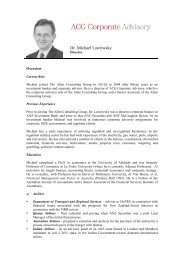Transend - Appendix 5 Renewal capital expenditure - Australian ...
Transend - Appendix 5 Renewal capital expenditure - Australian ...
Transend - Appendix 5 Renewal capital expenditure - Australian ...
You also want an ePaper? Increase the reach of your titles
YUMPU automatically turns print PDFs into web optimized ePapers that Google loves.
Burnie-Waratah 110 kV Transmission Line Wood Poles<br />
TNM-CR-808-0888<br />
Issue 1.0, November 2008<br />
EXECUTIVE SUMMARY<br />
This document assesses the condition of <strong>Transend</strong>’s population of wood poles currently installed on the<br />
Burnie–Waratah 110 kV transmission line.<br />
The Burnie–Waratah 110 kV transmission line was commissioned in 1967 and was constructed as a<br />
single circuit ‘H’ pole line with each support structure comprising two treated hardwood poles and a steel<br />
crossarm. The transmission line currently has 422 treated wood poles (two per structure) and 14 steel<br />
poles (one per structure) installed at 223 locations. The wood poles have installation dates ranging from<br />
1966 to 2001.<br />
The wood poles are tested every three years, with the next test regime to commence during summer in<br />
2010-11. These tests are undertaken by contractor Aurora Energy Pty Ltd (Aurora). Aurora is considered<br />
by <strong>Transend</strong> as the treated wood pole experts in Tasmania; in that it successfully manages a population of<br />
over 250 000 wood poles. <strong>Transend</strong> consequently utilise Aurora’s proven pole testing methodology.<br />
The treated wood pole failure rate for this transmission line when compared against the HEC/Aurora<br />
historical and estimated treated wood pole failure rate shows that the wood poles on this transmission line<br />
are failing at a faster rate (Trim Ref D08/68430). The earliest installed treated wood poles on this line are<br />
now 42 years old, and the estimated failure curve indicates that the last original treated wood pole on this<br />
transmission line will be replaced in 2033 (67 years old) as against 2039 (73 years old) from the<br />
HEC/Aurora data. The actual failure curve when forward estimated indicates that at least thirty poles,<br />
installed in 1966, are expected to require replacing in each future three yearly inspection cycle.<br />
During the 1980s the wood poles were reinforced by attaching a separate shorter pole to the existing pole<br />
as a support. This approach was found to be ineffective in providing sufficient support when it was<br />
identified that the internal weakening of the original pole was not only at or below ground level but also<br />
extended well into the upper portion of the pole. The internal weakening was also not limited to rot, but<br />
included a fungal attack through cracks of the outer surface of the pole as it weathers and ages. As such,<br />
reinforcement of an existing weakened pole, either by a separate supporting pole or metal stakes at<br />
ground level, is no longer recognised as a technically viable life extension option. Since the 1980s and<br />
until 2006, all condemned poles and the existing reinforced poles have been replaced with new treated<br />
wood poles.<br />
In 2006, an evaluation was conducted into replacing the wood poles with steel poles, as and when they<br />
were condemned. The report considered replacing both wood poles in the structure with steel poles. The<br />
report found that there was a whole of life premium of 14 per cent in replacing two treated wood poles<br />
with two modern steel poles. Further analysis has identified that replacing two wood poles with a single<br />
steel pole (for suspension structures) and two steel poles (for strain structures) is approximately 16 per<br />
cent cheaper than the traditional method. This revised pole replacement methodology was adopted and is<br />
currently being utilised.<br />
The future management strategy is to progressively replace the wood poles on this transmission line with<br />
steel poles, one at a suspension structure and two at a strain structure, as and when the wood poles are<br />
confirmed condemned through testing.<br />
Historical inspection and test results indicate that approximately 70 structures will be condemned and<br />
require replacement in the next planning period at a total cost of approximately $4.6m dollars.<br />
Page 4 of 9 © <strong>Transend</strong> Networks Pty Ltd<br />
UNCONTROLLED WHEN PRINTED







